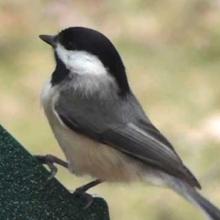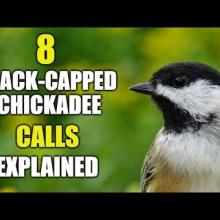

Join BirdNote tomorrow, November 30th!
Illustrator David Sibley and actor H. Jon Benjamin will face off in the bird illustration battle of the century during BirdNote's Year-end Celebration and Auction!
Imagine this Black-capped Chickadee flying toward its nest, carrying fresh insects for its chicks. A moment later, it emerges with a tiny white pouch in its bill. The chickadee drops the object into the vegetation below. That outgoing payload is a fecal sac, a remarkable adaptation found in nesting songbirds. Nestlings — often within seconds of being fed by an adult — excrete waste in tidy little sacs. Then the dutiful parent switches tasks, from meal delivery to waste management.
BirdNote®
Chickadees Clean up after the Youngsters
Written by Bob Sundstrom
This is BirdNote.
[Black-capped Chickadee calls http://macaulaylibrary.org/audio/98802 ]
An adult Black-capped Chickadee flies in toward its nest, carrying a beakful of fresh insects. Reaching a long-dead tree trunk, the bird disappears inside the nest cavity it’s excavated with its mate and delivers the goods to the impatient chicks within. [Black-capped Chickadee foraging calls http://macaulaylibrary.org/audio/51144 ]
A moment later, out pops the adult. But once again, it’s carrying something in its bill — what looks like a tiny white pouch. Still on the wing, the chickadee drops the object into the vegetation below.
That outgoing payload was a fecal sac, a remarkable adaptation found in nesting songbirds. Nestlings, often within seconds of begin fed by the adult, excrete waste in tidy little sacs with a gelatinous outer coating. The dutiful parent bird now switches tasks, from meal delivery to waste management. By dropping the sac a safe distance from the nest, the birds tidy the nest while discarding clues a predator might use to detect vulnerable nestlings. [Black-capped Chickadee calls, http://macaulaylibrary.org/audio/98802 ]
The fecal sac. For anyone who has ever changed a diaper, it’s a simple solution we can only marvel at.
For BirdNote, I’m Mary McCann.
###
Bird sounds provided by The Macaulay Library of Natural Sounds at the Cornell Lab of Ornithology, Ithaca, New York. Black-capped Chickadee calls [98802] recorded by G A Keller. Black-capped Chickadee forage sounds [51144] recorded by K J Colver
BirdNote’s theme music was composed and played by Nancy Rumbel and John Kessler.
Producer: John Kessler
Executive Producer: Dominic Black
© 2015 Tune In to Nature.org July 2018 / May 2023
Narrator: Mary McCann
ID # chickadee-03-2018-7-25 chickadee-03







